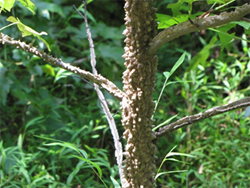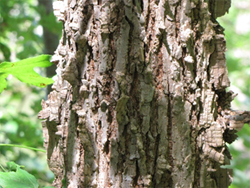Trees Covered in Cork
Trees Covered in Cork
By Bill Willis, NIEHS Site Ecology Team
November, 2015

Photo courtesy of Bill Willis
Have you seen trees in the area that look like they’re covered in cork? Have you wondered if these corky looking structures are naturally occurring or the result of some injury or disease? Or if you can safely tear the cork off the trees? In Europe there are real cork trees whose outer layer is harvested to make bottle corks. You may recall the story of Ferdinand the Bull and his love of flowers over bullfights. As the author, Munro Leaf, told the story, “[Ferdinand the Bull] had a favorite spot out in the pasture under a cork tree. It was his favorite tree and he would sit in its shade all day and smell the flowers.”
But we can’t claim to have these trees in North Carolina. To answer questions about what is going on with trees here at NIEHS, let’s take a closer look at the corky, winged bark on some of the younger trees on our campus.
While most people understand that bark is the outermost covering of typical tree trunks, “bark” is actually composed of several distinct layers in many trees. Trees that produce cork warts, also know as dimples or wings depending on the specific shape, have bark that includes several layers and have a second actively dividing cell layer (called “cork cambium”) just under the outer tree bark. Although occasionally these growths are the result of an infection, most of the time the growth is completely natural. The cork layer on the trees is best left undisturbed, as it provides the tree with additional protection from injury.

Photo courtesy of Bill Willis.
Cork is not a consistent feature on a specific species of tree; it can appear on some trees and not on others. Additionally, cork shape appears differently on different types of trees. On oak trees, it can appear as a continuous layer, while on elm and sweet gum trees, the cork forms sharp protrusions. Cork bumps can also change over time, becoming more rigid as the tree matures. Ash trees are particularly prone to growing cork wings, and their bark is typically soft, with deeply ridged cork bark that compresses to the touch.
Trees around the NIEHS campus have been spotted with different types of cork growth. The trees just before the Lake Trail Bridge #6 are examples on campus of healthy cork growth.



